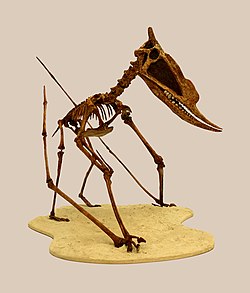| Dsungaripterus Temporal range: Early Cretaceous, | |
|---|---|
 | |
| Reconstructed skeleton | |
| Scientific classification | |
| Kingdom: | Animalia |
| Phylum: | Chordata |
| Class: | Reptilia |
| Order: | † Pterosauria |
| Suborder: | † Pterodactyloidea |
| Family: | † Dsungaripteridae |
| Subfamily: | † Dsungaripterinae |
| Genus: | † Dsungaripterus Young, 1964 |
| Species: | †D. weii |
| Binomial name | |
| †Dsungaripterus weii Young, 1964 | |
Dsungaripterus is a genus of dsungaripterid pterosaur which lived during the Early Cretaceous in what is now China and possibly South Korea. Its fossils come from the Wuerho Pterosaur Fauna group (WPF) of the Tugulu Group, comprising sections of the Lianmuqin and Shengjinkou Formations of the Junggar Basin. Both formations have been given various age estimates, with data suggesting at least some of the WPF date to the middle Valanginian, but the upper and lower bounds of these pterosaur bearing deposits remain unclear. [1]
















